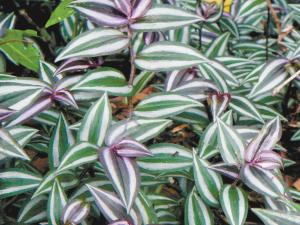Wandering Jew is ideal plant for beginners
One of the joys of winter is the great winter sky. As your gaze travels across the night sky, you may spot a starry wanderer, better known as a comet. Some people, like Arabs and Jews, made their living by wandering. The Jewish nation itself wandered for 40 years through the Sinai Desert. In the Middle Ages, a popular myth told of a porter in Pilate's service who mocked Christ for walking so slowly to his crucifixion. Christ told the insolent porter to wander the Earth and wait for the Second Coming. The Wandering Jew repented, was baptized Catholic, and wanders the Earth.
For gardeners, the aptly named Wandering Jew (Tradescantia zebrina) spreads or wanders across a pot or in mild climates across the garden. The Wandering Jew plant is native to the Gulf Coast of eastern Mexico. The leaves are an attractive zebra-stripe pattern, with the upper surface showing purple new growth and green older growth.
This is an easy-to-grow houseplant that will flower in spring or early summer with a range of colors from purple and pink to white. Plants do well in hanging baskets and soon drape over the edges, forming cascades of bright leaves.
This is such an easy houseplant, it is ideal for beginners, the elderly, or anyone who wants the benefits of a living, carbon dioxide-inhaling, oxygen-exhaling and breathing plant.
The Wandering Jew or inch plant likes moist soil and higher humidity levels. You can increase the humidity by lightly misting the leaves, especially in the dry, heated air of winter. While they do not need a lot of water, do not let them completely dry out or the roots might die.
To keep the plant full and bushy, cut off the growing tips from time to time. In fact, the plant itself is not long lived, but increases by constantly rooting stems where they touch the soil. Older plants may lose the leaves toward the base of their stems, making them look lean and straggly. Again, just cut it way back and it will regrow bushy and full.
Put the cuttings in a glass of water and within a few weeks you will have rooted plants to give away.
Fertilize about once a month with a water-soluble fertilizer. Wandering Jews flourish in bright but indirect sunlight. The more light your houseplant gets, the more it will bloom. If the leaves of your Wandering Jew begin to fade, it may need more light or repotting. Use a regular all-purpose potting soil with lots of rich organic matter such as compost. You can add sand, perlite or peat moss for better drainage.
While Wandering Jew plants are not known to be poisonous, some people and pets may get skin irritations from touching them.
Wandering Jew plants are widely available in pots, or perhaps a gardening friend will share a cutting. Pot up a hanging basket of Wandering Jew or put some cuttings in a glass on the windowsill. No plant is easier to grow, and no plant will cheer your dark winter nights better. The oxygen it releases will even freshen the dead air of January, perhaps enough that your mind will wander to the warm, sunny coast of Mexico, the true home of this flowery wanderer.




















































